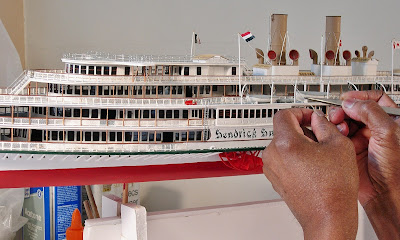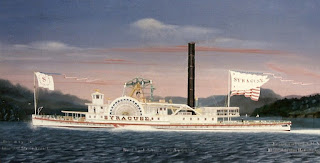Starboard overview of the much-heralded HENDRICK HUDSON as a scratchbuilt model.
It's been a year since the build of this historically accurate model which found it's home in its birth-city of Newburgh, New York. As I reflect, I think of the first model request I encountered some 33 years ago by one of the owner's family members, Alfred Van Olcott.
When he visited my artist studio that spring of 1987, he brought along with him the detailed blueprints of HENDRICK HUDSON. Al stated that he heard about my legendary echo up and down the Hudson Valley as being the only artist-craftsman that built accurate models of the Hudson River steamboats -both vintage and contemporary. He fixed his eyes on the ALEXANDER HAMILTON that was destined to a Scotia resident with another (in progress of the ROBERT FULTON).
Both models were a visual testament that convinced Olcott to commission. But what I found most interesting was his dissatisfaction of the family model that was exhibited at the Smithsonian in Washington, D.C. He stated that my work superceded the HENDRICK HUDSON showcased there and that he was honored to have come to Albany, New York to meet me. But, in reverse, I was honored to meet the former heir of the famous Hudson River Day Line.
So the saga began with him, a notable steamboat owner who passed the baton to me in an effort to honor a resident collector in the city where the famed HENDRICK HUDSON was built, Newburgh, New York.
In my last blog I left off building the main deck. In this blog, I cover the remaining build of the saloon, promenade and hurricane decks prior to finishing.
Below, with main decks, cabin and rail systems in place, I now advance to the next level working on saloon deck sections. I realize that blueprints give detail, but seldom are accurate...So, to get the work close to the actual appearance, much photo data is needed. However, I've built models based on just one or two photos.
As the build continue, I work up to the promenade deck -satisfied that the saloon and parlors are perfectly aligned as shown in the next images...
Stern starboard view of the finished saloon -minus the outboard seating, which will be added before enclosing the deck.
Being a historian has its advantages in the world of fine art...and craftsmanship. It's not enough to produce a fine piece, but rather make it as authentic as possible based on established history. It is never wise to label a thing 'authentic' if it can't be proven or backed with evidence. True collectors know that the research I place in the work is flawless...and some have amassed a series of models from my table as a result.
The HENDRICK HUDSON was the first largest steamboat to enter service on the river in 1907. She was built to celebrate the 300th anniversary of its namesake explorer who discovered New York's scenic river in 1609. Below, two supporting images show the launching of HENDRICK HUDSON at the T. S. Marvel Shipyard at Newburgh, New York.
The HENDRICK HUDSON is launched down the ways into the Hudson River, March 31, 1906 in view of 5,000 onlookers, shipyard attendees, and city officials. Below, the elegant and popular HENDRICK HUDSON backs around the "knuckle" of the Albany Yacht Club pier and into her berth after returning from a downriver excursion August 21, 1940.
The subject matter of these beautiful vessels is, nevertheless a hallmark for any builder who desires to pursue them. I was very fortunate to climb aboard into an era that would eventually fade away during the decade of the 1990s. Taking advantage of the opportunity, I worked diligently (and closely) with anyone who had first hand knowledge of these steamboats...But then again, I didn't have to go very far, because this special network came to me, re: family members (heirs) of those steamboats, curators, collectors, museum personnel, authors and even the passenger alumni themselves.
However, the key to it all were the business leaders, lawyers and judges, politicians, and private citizens who contributed and guided my research based on the integrity of trust. They all knew I would produce some of the most accurate pieces (without bias) in the Hudson Valley -and beyond. For that, I knew this was one of my purposes as an artist-craftsman relative to documenting the river's transportation legacy in the form of model steamboats.
Continuing with the build, I now work on the promenade deck with both excitement and anticipation. The supporting images show how awesome the designers were in those times. Their expertise in symmetric design not only made HENDRICK HUDSON a sleek looking vessel, but her interior elegance was second to none.
This port profile view show the progress made on the promenade deck of HENDRICK HUDSON. The total build time for this deck area was two and a half weeks.
Upon completing the promenade, I carefully aligned the hurricane deck -making sure the stacks, pilothouse and skylights were properly aligned...using for reference the original deck plan(s) and vintage photo (shown below). The hole that is seen on the hurricane I cut the hole seen on the hurricane above the sliding doors of the observation cabin. The effect that I wanted was to have light penetrate the windows of the roof dome to illuminate the interior cabin and stairwell. This can also be seen in the second photo which highlight the stairwell which was known as "Stairway of the Dragon".
Vintage photo that assisted with the HENDRICK HUDSON build. This photo was one of many given to me by Herman Boyle of Kingston, New York during my several Saturday visits to his home on Washington Street. He was a riverman that worked on the tugs, but had a large collection of vintage photos depicting steamboat life on the Hudson River.
Interior view of the observation parlor showing the skylight dome over the stairwell leading down to the saloon cabin. In the view looking forward is a mural of the Dutch VOC sailing ship Half Moon. The HENDRICK HUDSON, in all her breathtaking elegance, not only had this feature mural, but others of note in various locations.These commissioned pieces were Washington Irving's home, the Senate House at Kingston, and the Capitol at Albany, New York.
Moving along in the build (shown below), I discovered additional details which I applied to the model that was absent from the early Olcott commission. And though that model was featured in a televised PBS documentary, this HENDRICK HUDSON would break ground to be one of the best ever produced.
Below are work in progress photos of the promenade and shade decks...
Here, I attach flags prior to finishing. This is usually done to avoid premature damage to the model while addressing delicate details. Furthermore this procedure forces me to concentrate on the total build while working in segments. Elegance, even in miniature comes with a price -which is time, effort and patience.
The HENDRICK HUDSON was indeed elegant, and wasn't rushed into service as some historians have stated. Her true test came the following year in 1907, not 1906 as some have documented. Even the heir of the family business told me her true service began during the 1907 season..Only a trail run occurred in August of that year. A partial schedule (below) confirms her official 1907 service year..
When Ellis Island was established in 1892, immigrants from around the world came to America for opportunity and a better life. Through the period between 1892 and 1901 many immigrants remained in New York City, but some ventured west and south to apply their trade and skills. It was the Industrial Age and practically everyone had a vision to prosper.
Working in the shipyards and coastal cities along the Hudson River presented those opportunities and steamboating became a business that generated income for any culture willing to endorse it. As a result, when the Hudson River Day Line welcomed these cultures, it gave them honor by celebrating their contributions in the Hudson Valley by flying international flags on its fleet. Below are three port and starboard views showing these flags which were occasionally rotated.
The first set of flags represent The Netherlands and France. The second set are the countries of Canada and Norway. The third, flags of Italy and Denmark. Finally, on the back staffs (not visible) are the flags of Japan and Puerto Rico.
As a collectible and investment, I produce these models with as much accuracy as possible and integrate them with history by way of these blogs. It's who I am as an artist, craftsman, visionary and historian. Research is not centered on biases, but rather on evidence that support the quality of workmanship I was given to do. So to that end, I close this portion of "Modelling HENDRICK HUDSON -Newburgh's Own"...with anticipation of soon presenting the finale.
For those who would like to own one of these prolific models -or any notable Hudson River steamboat, I can be contacted at Caseships@yahoo.com...or, at 774-757-7137 for details. My credentials can be found at https://www.linkedin.com/in/rexstewart and https://youtube.com/c/RexStewartoriginals.
Thank you for viewing!

















































